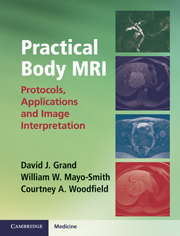Book contents
- Frontmatter
- Contents
- Preface
- To the reader
- Acknowledgments
- Glossary of terms andabbreviations used in Body MRI
- Section 1 Body MRI overview
- Section 2 Abdomen
- Chapter 2 Liver
- Chapter 3 Pancreas and biliary tree
- Chapter 4 Kidneys
- Chapter 5 Adrenal glands
- Chapter 6 MRI enterography
- Section 3 Pelvis
- Section 4 MRI angiography
- Index
- References
Chapter 4 - Kidneys
from Section 2 - Abdomen
Published online by Cambridge University Press: 05 November 2012
- Frontmatter
- Contents
- Preface
- To the reader
- Acknowledgments
- Glossary of terms andabbreviations used in Body MRI
- Section 1 Body MRI overview
- Section 2 Abdomen
- Chapter 2 Liver
- Chapter 3 Pancreas and biliary tree
- Chapter 4 Kidneys
- Chapter 5 Adrenal glands
- Chapter 6 MRI enterography
- Section 3 Pelvis
- Section 4 MRI angiography
- Index
- References
Summary
Renal mass protocol
Indications
This protocol is used for evaluation of renal mass(es)/lesion(s), polycystic kidney disease, and hematuria.
Preparation
IV contrast agent: 1 mmol/kg gadopentetate dimeglumine at 2 cc/s
Oral contrast agent: None
2 L nasal oxygen
At least 24-gauge IV; connect to power injector
Subtract volume-interpolated gradient echo pre from each dynamic post volume-interpolated gradient echo post sequence.
Exam sequences
(1) Diffusion weighted imaging b50, 500/ADC – Very sensitive for lesion detection.
(2) Coronal T2 single-shot fast-spin echo FS BH – Identify T2-bright lesions and septations/nodularity within them.
(3) Axial single-shot fast-spin echo T2 non FS BH – Identify T2-bright lesions and septations/nodularity within them.
(4–5) Axial in- and out-of-phase BH (IP/OOP) – Evaluate masses for microscopic fat.
(6) Axial volume-interpolated gradient echo pre – Identify foci of T1-bright signal before contrast administration. Also assess for macroscopic fat via comparison to in-/out-of-phase images.
(7) Coronal volume-interpolated gradient echo pre – Identify foci of T1-bright signal before contrast administration.
(8) Coronal volume-interpolated gradient echo post at 30 seconds, 1 minute, and 2 minutes – Assess for enhancement.
(9) Axial volume-interpolated gradient echo at 3 minutes – Assess for enhancement.
Information
- Type
- Chapter
- Information
- Practical Body MRIProtocols, Applications and Image Interpretation, pp. 49 - 57Publisher: Cambridge University PressPrint publication year: 2012
